Wild Animals are Worthy of Humane Care, Too
By Sam Emmerich, Dane County Humane Society Animal Medical Services Intern and Four Lakes Wildlife Center Intern
Photographs taken by Sam Emmerich at the Four Lakes Wildlife Center
Photographs taken by Sam Emmerich at the Four Lakes Wildlife Center
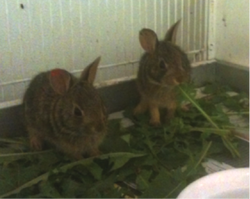
While humane societies and animal shelters primarily house companion animals and livestock to a lesser extent, wildlife often find their way into these places as well. Behaviorally, wild animals are much different than domestic animals and consequently must be treated and handled differently.
I found an injured or orphaned wild animal. Now what?
First and foremost, you should consider if the wild animal really does need care. Many wild animals brought in for rehabilitation are victims of “nest stealing,” in which perfectly healthy and cared for infants are taken from nests after being erroneously identified as abandoned. If the wild animal is visibly injured, is unresponsive to stimulation, or has been abandoned for over a day, then contact a licensed wildlife rehabilitator. If the wild animal is a threat to humans or pets, an animal services officer should be contacted. While veterinarians in a shelter setting are usually willing to give medical care, they may not have the specialized knowledge required to provide care for wildlife. To get in contact with a rehabilitator, call a local rehabilitator in the Department of Natural Resources’ Wildlife Rehabilitators State Directory (for WI: http://dnr.wi.gov/topic/wildlifehabitat/directory.html). Additionally, if you deem it unsafe to handle the animal, call an Animal Services dispatcher (608-255-2345). If these resources are unavailable, the animal should be brought to an emergency animal clinic.
I found an injured or orphaned wild animal. Now what?
First and foremost, you should consider if the wild animal really does need care. Many wild animals brought in for rehabilitation are victims of “nest stealing,” in which perfectly healthy and cared for infants are taken from nests after being erroneously identified as abandoned. If the wild animal is visibly injured, is unresponsive to stimulation, or has been abandoned for over a day, then contact a licensed wildlife rehabilitator. If the wild animal is a threat to humans or pets, an animal services officer should be contacted. While veterinarians in a shelter setting are usually willing to give medical care, they may not have the specialized knowledge required to provide care for wildlife. To get in contact with a rehabilitator, call a local rehabilitator in the Department of Natural Resources’ Wildlife Rehabilitators State Directory (for WI: http://dnr.wi.gov/topic/wildlifehabitat/directory.html). Additionally, if you deem it unsafe to handle the animal, call an Animal Services dispatcher (608-255-2345). If these resources are unavailable, the animal should be brought to an emergency animal clinic.
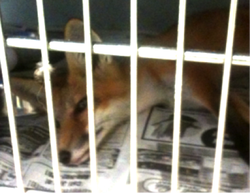
How does one safely handle a wild animal?
If the injured animal is small enough or weak enough to handle, it is permissible to capture the animal and bring it to a wildlife rehabilitator yourself. When handling a wild animal, follow these guidelines:
Should I be concerned about disease transmission?
Yes. Coming into contact with wild animals may expose you to a variety of diseases. These diseases could be directly transmissible to you (zoonotic), your pets, or other wild animals. Rigorous glove-use and hand washing when handling wild animals greatly reduces the risk of contacting these diseases. It is always better to err on the side of caution; even if an animal is not presenting any signs of disease, you should still treat it as infected. If you have been bitten or scratched, you should seek medical attention immediately. Likewise, if your pet comes in contact with the wild animal, you should seek veterinary advice.
If the injured animal is small enough or weak enough to handle, it is permissible to capture the animal and bring it to a wildlife rehabilitator yourself. When handling a wild animal, follow these guidelines:
- Wash hands and any other body part that may contact the animal before and after handling.
- Wear rubber or leather gloves to protect yourself from bites and scratches.
- Wear insect repellent, to prevent insects from the animal from invading your body.
- Move slowly and try not to corner or crowd the animal to avoid fearful aggression.
- Avoid contact with feces, body fluids, and decomposing carcasses.
- Cover the animals eyes or head with a soft, breathable fabric to reduce stress.
- Handle only long enough to put into a transport container; unlike domestic animals, over-handling can cause dangerous levels of stress.
- Do not cuddle, play with, or manipulate wild animals.
- When transporting, ensure a safe and quiet environment by refraining from listening to music, avoiding extreme temperatures, and securing transport container.
- Note: seek care as soon as possible if an injured wild animal is deemed necessary. This is imperative for small animals with high metabolisms like songbirds.
Should I be concerned about disease transmission?
Yes. Coming into contact with wild animals may expose you to a variety of diseases. These diseases could be directly transmissible to you (zoonotic), your pets, or other wild animals. Rigorous glove-use and hand washing when handling wild animals greatly reduces the risk of contacting these diseases. It is always better to err on the side of caution; even if an animal is not presenting any signs of disease, you should still treat it as infected. If you have been bitten or scratched, you should seek medical attention immediately. Likewise, if your pet comes in contact with the wild animal, you should seek veterinary advice.
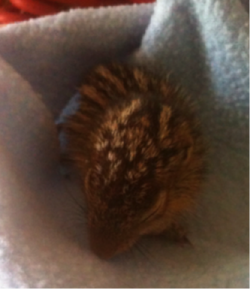
What are some zoonotic diseases that I could be exposed to?
Rabies – a viral disease that infects warm-blooded animals, but mostly carnivorous or omnivorous mammals. Transmitted by saliva or tissue, especially through traumatic bites. In some cases, rabies makes an animal act atypical or ‘dumb,’ but every carnivorous mammal (foxes, bats, skunks, raccoons, weasels, etc.) should be treated as if they are rabid. It is nearly 100% fatal once manifested in the host, so only experienced animal control personnel should handle potential rabies hosts.
Lyme disease – a bacterial disease transmitted by ticks. Ticks from any tick-infested animal may pass it on to humans. Symptoms are flu-like and accompanied by joint pain and sometimes a target shaped rash. It is treated with antibiotics.
Hantavirus – a viral disease that is found in rodents (especially Deer Mice) and transmitted to humans that ingest or inhale rodent feces or body fluids. The virus causes respiratory ailments in humans. No surefire treatment exists; the best treatment is prevention.
Sarcoptic mange – a mite that is found on mammals like squirrels, rabbits, and foxes. Transmitted by contact from an infected host. Mange mites cause itchy red scabs on humans, but are easily treatable with medicine.
Salmonellosis – a bacterial disease that is transmitted to humans through rodent or bird feces or from the skin of reptiles. It causes food poisoning but is readily avoided by wearing gloves, washing hands, and avoiding animal feces.
What type of care can a wild animal receive?
Orphaned animals are usually raised on formula or nestling bird diet and once they are of aged, released into the wild. Unfortunately, young animals have a high risk of imprinting on humans or becoming conditioned to associate them with food. If wild animals lose their ‘wildness’ in these ways, they become non-releasable.
Rabies – a viral disease that infects warm-blooded animals, but mostly carnivorous or omnivorous mammals. Transmitted by saliva or tissue, especially through traumatic bites. In some cases, rabies makes an animal act atypical or ‘dumb,’ but every carnivorous mammal (foxes, bats, skunks, raccoons, weasels, etc.) should be treated as if they are rabid. It is nearly 100% fatal once manifested in the host, so only experienced animal control personnel should handle potential rabies hosts.
Lyme disease – a bacterial disease transmitted by ticks. Ticks from any tick-infested animal may pass it on to humans. Symptoms are flu-like and accompanied by joint pain and sometimes a target shaped rash. It is treated with antibiotics.
Hantavirus – a viral disease that is found in rodents (especially Deer Mice) and transmitted to humans that ingest or inhale rodent feces or body fluids. The virus causes respiratory ailments in humans. No surefire treatment exists; the best treatment is prevention.
Sarcoptic mange – a mite that is found on mammals like squirrels, rabbits, and foxes. Transmitted by contact from an infected host. Mange mites cause itchy red scabs on humans, but are easily treatable with medicine.
Salmonellosis – a bacterial disease that is transmitted to humans through rodent or bird feces or from the skin of reptiles. It causes food poisoning but is readily avoided by wearing gloves, washing hands, and avoiding animal feces.
What type of care can a wild animal receive?
Orphaned animals are usually raised on formula or nestling bird diet and once they are of aged, released into the wild. Unfortunately, young animals have a high risk of imprinting on humans or becoming conditioned to associate them with food. If wild animals lose their ‘wildness’ in these ways, they become non-releasable.
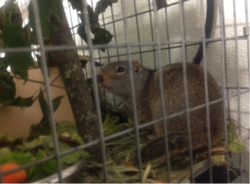
Adult animals that have become emaciated, dehydrated, or weak due to a lack of food or being confined for long periods of time can usually be rehabilitated with a strict feeding regiment, fluid replacement, and physical therapy.
Injuries in wild animals are usually much harder to overcome. In order for rehabilitation and release to be humane, the animal must be able to exist self-sufficiently in a wild environment. This means that birds must be able to fly, mammals able to crawl, turtles able to swim, etc. Some injuries are too severe to meet these requirements. Common injuries in Wisconsin wildlife that can often be treated include turtle shell fractures, bone fractures, eye trauma, and infected wounds. Medical treatment can involve prescription medications to treat pain, parasites, infections, and other ailments as well, highlighting the value of veterinarians trained in wildlife medicine.
It is important to conclude on this note: providing treatment to a wild animal without a license is illegal. It can be dangerous to you and to the wild animal when done incorrectly. Truly, the best course of action is to be sure that the animal really does need help and then contacting the appropriate parties to begin the rehabilitation.
Injuries in wild animals are usually much harder to overcome. In order for rehabilitation and release to be humane, the animal must be able to exist self-sufficiently in a wild environment. This means that birds must be able to fly, mammals able to crawl, turtles able to swim, etc. Some injuries are too severe to meet these requirements. Common injuries in Wisconsin wildlife that can often be treated include turtle shell fractures, bone fractures, eye trauma, and infected wounds. Medical treatment can involve prescription medications to treat pain, parasites, infections, and other ailments as well, highlighting the value of veterinarians trained in wildlife medicine.
It is important to conclude on this note: providing treatment to a wild animal without a license is illegal. It can be dangerous to you and to the wild animal when done incorrectly. Truly, the best course of action is to be sure that the animal really does need help and then contacting the appropriate parties to begin the rehabilitation.
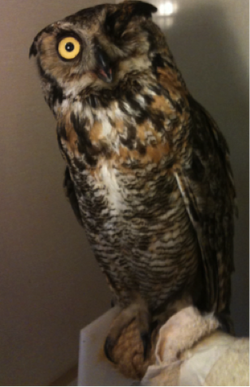
Sources
Diseases
http://icwdm.org/handbook/damage/wildlifediseases.asp
Avoiding Disease
http://web.extension.illinois.edu/wildlife/health_zoonoses.cfm
Handling
http://archive.ilmb.gov.bc.ca/risc/pubs/tebiodiv/live-animal/
Mange
http://www.wisconsinfederatedhs.org/what-is-mange-anyway.html
Rabies
http://www.cdc.gov/rabies/index.html
Four Lakes Wildlife Center
http://www.giveshelter.org/four-lakes-wildlife-center.html
Diseases
http://icwdm.org/handbook/damage/wildlifediseases.asp
Avoiding Disease
http://web.extension.illinois.edu/wildlife/health_zoonoses.cfm
Handling
http://archive.ilmb.gov.bc.ca/risc/pubs/tebiodiv/live-animal/
Mange
http://www.wisconsinfederatedhs.org/what-is-mange-anyway.html
Rabies
http://www.cdc.gov/rabies/index.html
Four Lakes Wildlife Center
http://www.giveshelter.org/four-lakes-wildlife-center.html
